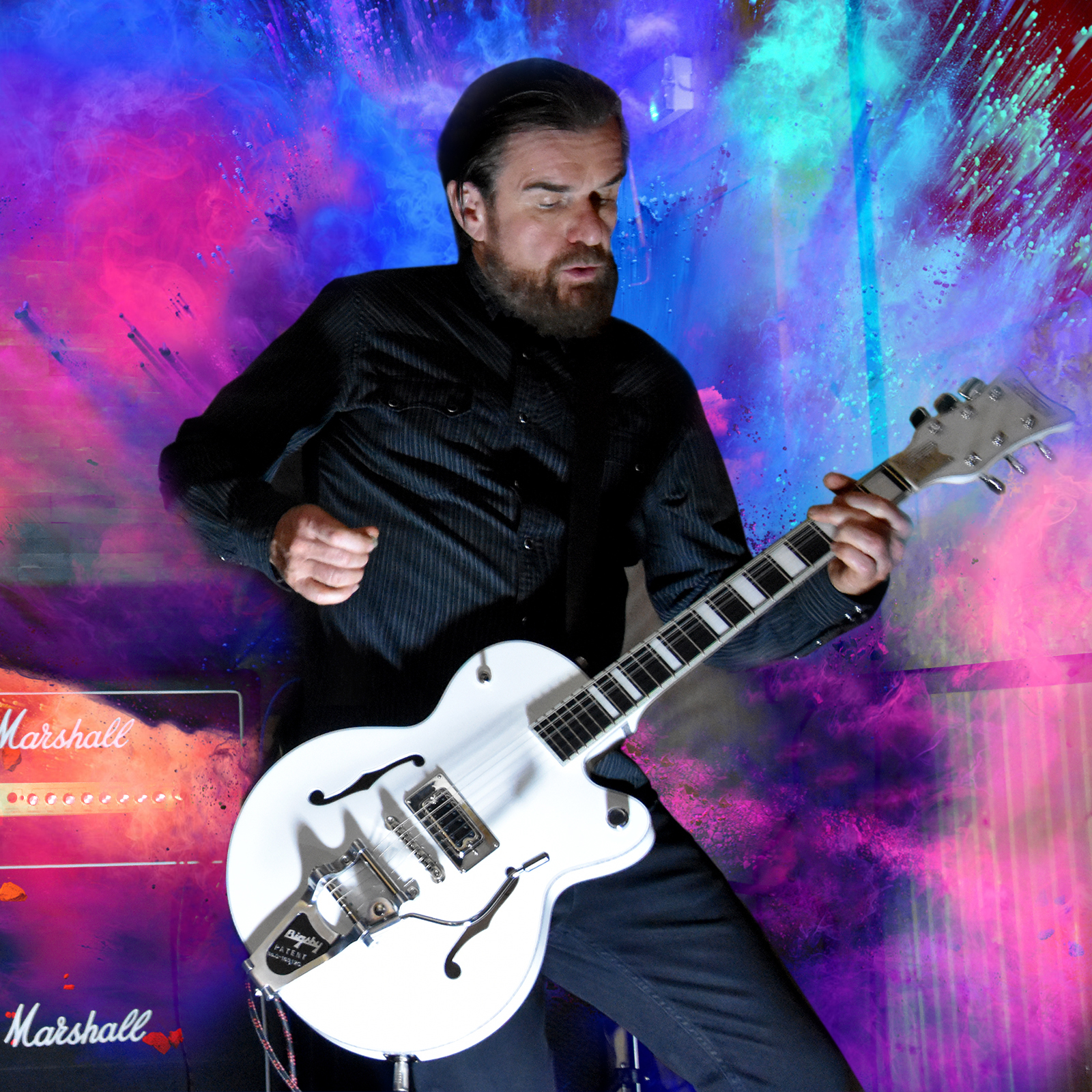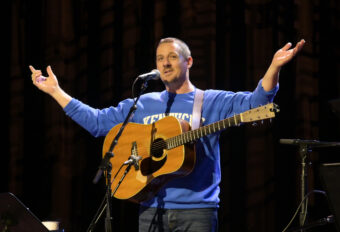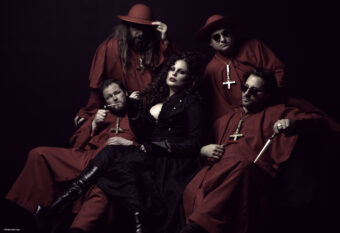On a likely wet and dreary Manchester, England day, sometime around the mid-’70s, a young Billy Duffy was reading music rags and dreaming of becoming a rock star. “Those were our Bibles,” he says. “We would pour over them in the morning before school when they were delivered to the paper shop and get them from the corner store.” Now 60, he recalls with certainty: One came out on Wednesday, two on Thursday. “You would devour them for reviews of concerts, new albums, photographs of mystical musicians who lived in California. We would just devour all that and scope the world that existed out there and then we’d go and traipse off to school and get rained on.”
When he was about 13 or 14, his parents finally relented and bought him a guitar. “I went and asked my parents and they agreed to buy me a little guitar and an amplifier, bless them,” he says. He’d formed a band with a friend who played drums, and another kid down the street who played bass. With Billy and his new guitar they were destined for stardom—except for one little detail. “I remember the first time I sat down with a guitar on, with these other musicians and there was a tuning fork, because I knew you had to tune the guitar and there were no electronic tuners, so you banged the tuning fork and tune the guitar off that. We’re talking ’75 maybe ’74, and then I realized—I actually couldn’t play anything. I had the amp, I had the guitar, I had the haircut, I had the jacket, something like Aerosmith on the back…I thought I was like the bee’s knees. I had everything. I had all the gear and no idea [how to play].”
But Billy played guitar. By the time he was 18 he’d honed his signature heavy, hypnotic sound, and he’d moved to London, joined a band and was offered his first record deal. But before leaving, in an ordinary moment that would eventually lend itself to future rock ‘n roll folklore, he gave his amp to this “cool young kid” who lived across the street and used to come over to watch them play. He helped set this boy—Johnny Marr—on a fated path. “He ended up joining a band later with some of those guys after I’d gone off to London,” Billy says. “That was one of his stepping stones towards ending up in the Smiths.”
Since forming The Cult in 1983, Billy and lead singer Ian Astbury have continued to keep the flame alive throughout the decades. But in the late-90s, on an amicable break from The Cult, Billy ran into Mike Peters, also on a break from The Alarm. In 1999 they released their debut eponymous album, right when The Cult re-formed. Difficult decisions were made, and despite the new album, COLOURSØUND would have to wait to do anything further.
Now, 22 years after their striking debut, COLOURSØUND are releasing COLOURSØUND II on July 16. So much life’s been lived in over two decades, but the camaraderie and unshakable alignment between Mike and Billy can be felt in every song. “We get on, great. Like brothers from another mother we get on really well,” Billy says.
“I just want people to get the vibe,” he adds. “COLOURSØUND’s a good thing. It’s just a good thing. It’s a positive thing for people. It’s like getting an extra portion of French fries. It’s free, it’s a bonus. It’s just like, ‘If you like those two bands [The Cult and The Alarm], it’s likely you might enjoy this, and me and Mike enjoy doing it.”
It’s just the two of them, two friends making an undeniable, unmistakable, electric rock ‘n roll record. Billy and Mike do everything in-house. “There’s no record labels, we are the label,” Billy says. “It’s just purely for the enjoyment of the people who they take the spirit of rock and roll in a certain era and hopefully, they can enjoy it for that. There’s a load of great music out there that’s being made. It’s definitely not one of those things where it’s like, ‘Well, our music was better in our day.’ It is what it is. Music is ever-evolving and that’s a great thing.”
He adds: “When you can find a situation that is something that’s creative and enjoyable and fun and no headaches, really…I cherish it.”
SPIN: Congrats on the new album.
Billy Duffy: Well, thank you. It was conceived pre-COVID and consummated during COVID so it worked out in a way, very harmoniously. COLOURSØUND, it’s a very British little project and intentionally so, we wanted to keep it us British players on bass and drums and just keep that kind of flavor just to separate it off from what Mike [Peters] does and what I do with The Cult and just see if we could.
I personally like recording in residential studios. It’s one of my little personal likes where I like to get away from my home environment and immerse myself in the music and not have to worry about the gas bill, or whatever. I just want to immerse myself in the bubble. I got to do that and I really enjoyed that with COLOURSØUND. There will be a new Cult album. It just takes its time and it’s a different kind of creative process.
There were 22 years between your first COLOURSØUND album and this one. It’s almost like a different life, don’t you think?
Yes, I’d agree. In some ways, I do think that that the previous COLOURSØUND album, it just basically got lost in the shuffle because we did the album, we started to promote it, and then I got the call about The Cult. In ’99 I had to make a very difficult decision because I get on great with Ian Astbury. He didn’t want to do The Cult for a few years, it got on top of him and I understood why and could relate, but then he wanted to have another go with doing it. I’m glad I did. That’s my life’s work. Unfortunately, the casualty of that was the first COLOURSØUND [album]. What he did do, I think Mike’s mentioned it a few times in interviews, how it inspired him to reimagine what The Alarm could be. I think he got the idea of working in a band together where it was healthy got him inspired to reimagine The Alarm as a healthy forward-thinking band. There was some positivity that came out of it. He’s been busy these last 20-odd years.
Reconfiguring it so that it’s healthy is so important.
Maybe it’s a phase of my life that I’m possibly more reflective…I’m not terribly hung up on it but once you get your mind right and just get your head on straight and then the rest of it will just follow because you’ll just make good decisions for the most part, hopefully.
Your sound is so unique.
Thank you. With The Cult, sometimes I probably have to compromise to work with the shared vision with Ian as a team thing, but with COLOURSØUND it’s just basically unfiltered Billy Duffy. You capture a moment of feeling, the energy, and I don’t overthink it too much. It’s just fairly spontaneous and I think that’s great.
The Cult, maybe what I do is a little more studied and considered because of the nature of the working relationship with Ian and the fact that me and Mike have only made two albums together, me and Ian have made 200.
How different was the process from the first COLOURSØUND album to this one?
The biggest difference I think was that when we did the first COLOURSØUND album, I was a bit like a nomad. I’d been in The Cult for 13 years with very little time off. I literally mean a week here a week there. The Cult was all-consuming. That was great but when that stopped, it created a bit of a vacuum in me. It stopped halfway through a tour. I really didn’t know what I wanted to do. I ended up gravitating back to England for a reset with my family and friends…the things that I had to sort of slightly put on the back burner to pursue a career in rock and roll and in that period. Mike and I ended up becoming pals and he invited me over his house in beautiful North Wales and we both did fly triking and the outdoors and stuff. That was how that came about.
The way we did this [album] was very similar. I sent Mike a riff that I had laying around that I knew wouldn’t get used for The Cult and he loved it and fired back a great bit that I couldn’t think of as a verse. That’s how we came up with that song “Paradise”. We thought, “Well, that’s fun. That sounds pretty cool.” Mike had been mentioning about this place he knew on the coast in Wales, it was a little cottage and we thought, “Well, let’s why don’t we do that?” Every musician in the world knows about Jimmy Page and Robert Plant going to that cottage. As Robert Plant very amazingly said, “Yes, we went to a cottage in Wales and wrote songs about being in California.” [Laughs.]
Which is what they did. That idea is part of my rock fantasies, like me and a singer just going away somewhere and just woodshedding and writing. That’s what we did for three days and came up with I think seven or eight basic ideas, which became the basis for the second COLOURSØUND album. Then that was it. I think I went back to America, Mike worked on those very rough ideas and got his vocals sorted out so he knew what he wanted to do. When we went in the studio, it was just a question of putting the right bass and drums together and it works out really well.
It sounds like you just get along really well.
It’s very easy we’re just good friends. Don’t get the idea of seeing him every weekend. I don’t see Mike but we’ve just got a very easy, comfortable relationship. We have a very similar upbringing in the Northwest of England and he was in Wales. North Wales is a bit like where a lot of people from Manchester and Liverpool go. There’s the original people from North Wales and then there’s all these other people hiding out. It’s an interesting blend of characters you get in North Wales because it’s very close. It’s 45 minutes in a car, an hour. We have a very similar background in terms of our experiences growing up in the pre-punk and punk rock phase in the UK.
We formed our basis of our mentality. It’s in our DNA. If you lived through the punk period, it’s in there in some way shape or form because it was a monumental shift. Even if you hated it and kept wearing flares and long hair, you would be aware of it and it did impact your life.
You grew up in Manchester?
Yes, I lived in Manchester ’till just before I was 18 and then I moved to London. I joined a band. The band offered me a job with a wage and an apartment and a record deal. I was living with my parents, signing on unemployment and I was like, “Let me think about that for about half a second.” [Laughs.]
I was already packing my bags and I took off for my little career. I packed my bag and went away to the circus but that’s what happened for me. I had a couple of years in Manchester of the punk thing and a couple of years before that, going to see any rock band of any kind that I could possibly sneak in to see if I couldn’t afford a ticket. That was my youth was going to see–
It’s funny when you think back, obviously, you would expect me to see Queen or The Who, but you wouldn’t expect me to see maybe…Lynyrd Skynyrd, Ted Nugent, on his first album. I saw those bands, as well. When punk happened I would go and see any band. I still have my tickets from Mott the Hoople with Mick Ronson on guitar and they canceled the tour and I’m still heartbroken. I’m 60 and I’m still heartbroken. [laughs again]
I’m heartbroken for you!
Like I said, Mike’s the same and we were both fans. I think in the end, there’s a whole generation of musicians whose bands started probably around ’79, ’80, ’81, where we all grew up loving punk but didn’t want to copy it. We just took the energy and the excitement of seeing the original punk bands. “Well, what can we do to make it our own?”
There was a whole generation of what sadly got called post-punk but to me, it was the fans of punk who lived to play. We all went on trying to find different ways of expressing ourselves musically. I ended up with a big white guitar and a rockabilly haircut for a minute. It was just a bunch of factors and everybody has their own story. The Edge started playing with effects. There was loads of great bands, The Bonny Men, Killing Joke, Sisters of Mercy, Millions. The Cure came in ’79, Depeche Mode, keyboards, heavy — New Order came out, Joy Division. The Smiths in ’83. The thing we had mostly in common was all the players in those bands probably were influenced by punk bands.
It’s funny how all roads seem to lead to punk somehow.
We were into energy but maybe we’re more into melody and the original– To me, when the Sex Pistols broke up [ along came] the more progressive punk bands, like say, obviously, the Clash, and Siouxsie and the Banshees, and went on to have long careers.
Then there was a whole second wave of a retrograde punk that was just almost to me like cartoon music. There was no real heart to it. It was just all seem to be play-acting. I found that singularly unappealing. I really would happily listen to a Lynyrd Skynyrd album.
That stuff was so inspired.
Yes, it was. That’s where we were with the COLOURSØUND album. I just think the goal of COLOURSØUND is really — I don’t want people to think it’s some lazy excuse for two guys to go drinking and getaway to escape from their wives. It’s very much something that’s done for the right reasons and love and a passion for music and friendship. It’s something that we hope that the fans of the kind of rock and roll that we do will enjoy because I don’t think there’s a tremendous amount of it out there.
Rock and roll records like COLOURSØUND aren’t as common as they used to be.
One of the conversations I’ve had with Ian Astbury when we were doing Cult stuff — I think it’s harder as you get older to write cool, uptempo rock songs. It’s actually more challenging to me. As bands and people mature, they tend to slow down, get more introspective, more melancholic, and a bit more self-indulgent. I think it’s harder to keep lean, mean, and that’s what we try and do with COLOURSØUND. Don’t overcomplicate it, keep the edge to it, keep it feeling like there are humans in a room making music and hopefully, that chemistry comes across.
There’s something exciting about maybe hearing something that was written in the last year that rocks, and isn’t trying too hard to be contemporary or chasing whatever the zeitgeist at the moment is. It hopefully comes across like that. It was just fun. I keep saying fun. We all had fun doing COLOURSØUND and that’s the essence of it.
I don’t think you should ever apologize for saying that something’s fun because I don’t think everybody’s having fun.
I know a lot of musicians and I would say that probably the vast majority don’t do fun.
Are you going to tour at all?
Well, that’s a good question. Something’s going to come up when there’s a right opportunity to do COLOURSØUND but to gear up an entire band? We’d have to find an opportunity for COLOURSØUND to make sense to play live but I’d love to do it. Me and Mike have talked about it. The COLOURSØUND music is, if nothing else, real live rock and roll or organic music. It should be shared with an audience and some sweat. I think we’d like to do that for sure.




